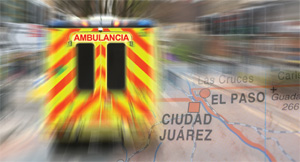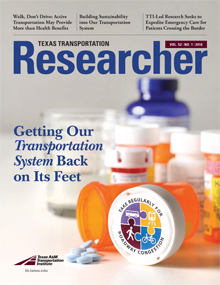Led by the Texas A&M Transportation Institute (TTI), a team of public agencies including the Texas Tech University Health Sciences Center El Paso (TTUHSC El Paso) Department of Neurology, the El Paso Fire Department (EPFD) and Mexican ambulance companies are conducting research to speed up cross-border transportation for heart attack and stroke victims. Mortality rates increase sharply as time increases from incident to treatment, but quickly getting patients the care they need is sometimes challenging with tightened security measures at the border.
Evaluating Ambulance Cross Border Operations and Its Impact on Public Health in Border Regions is a project funded by TTI’s Center for International Intelligent Transportation Research (CIITR) and TTUHSC El Paso. The ultimate goal of the project is to establish an operational protocol to expedite ambulance cross-border operations in the El Paso–Ciudad Juarez binational region.
“We are in the early stages of conducting meetings with all the stakeholders. We’re looking at current operational protocols and determining where the process can be streamlined to get emergency patients to El Paso hospitals quicker so treatment can begin earlier,” says David Salgado, TTI associate transportation researcher for CIITR and principal investigator on the project.
Currently, when a patient suffering a stroke or heart attack is transported from Juarez to El Paso, Mexican ambulances carry him or her to the border, where the patient must have the proper paperwork to cross. Once cleared by CBP, the patient is transferred to an EPFD ambulance that takes him or her to a U.S. hospital. In cases where the proper paperwork is missing, a border agent must ride with the patient to the hospital until the individual’s status is confirmed.
“Stroke is the number one cause of disability in the United States,” says Gustavo Rodriguez, M.D., TTUHSC El Paso neurologist. “It is imperative that stroke patients be treated quickly with a specialized clot-busting drug. Otherwise, the patient can suffer permanent damage.”
“Part of the delay occurs because, currently, CBP is not notified that an ambulance is en route to the border with a patient,” Salgado says. “Perhaps a pre-notification process can be established in which not only is CBP notified, but so is EPFD. Consequently, Mexican ambulances, CBP, and EPFD are fully coordinated and aware of the situation in real time.”
Researchers are currently studying how many patients are being transported and the magnitude of the delay problem. To that end, other stakeholder meetings are being planned, as well as a workshop to outline recommendations.
“If there is a weak link in this process, we need to find it,” says Lt. Oscar Salazar of EPFD. “If the border is part of the problem, we need to fix it. We want to make this as seamless as possible.”

